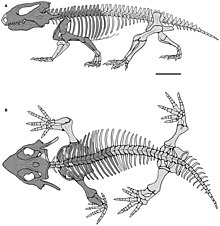Kapes(genus)
| Kapes Temporal range:Lower-Middle Triassic
| |
|---|---|

| |
| Skeleton ofKapes bentoni | |
| Scientific classification | |
| Domain: | Eukaryota |
| Kingdom: | Animalia |
| Phylum: | Chordata |
| Class: | Reptilia |
| Clade: | †Parareptilia |
| Order: | †Procolophonomorpha |
| Family: | †Procolophonidae |
| Subfamily: | †Procolophoninae |
| Genus: | †Kapes Ivakhnenko,1975 |
| Species | |
| |

Kapesis an extinctgenusofprocolophonidparareptilefrom theLowerandMiddle Triassicof the United Kingdom and Russia. ThetypespeciesK. amaenuswas named in 1975 from the banks of theVychegda Riverin theKomi Republicof Russia. In 1983, a new species was brought into the genus,K. majmesculae.K. majmesculaewas first named in 1968 as a member of the genusTichvinskia.A third Russian species,K. serotinus,was named in 1991. In 2002,Kapes bentoniwas described from theMiddle TriassicOtter Sandstone FormationofDevon, England,extending the geographic range ofKapes.In the same paper,K. serotinuswas synonymized withK. majmesculaeand another Russian species was assigned toKapescalledK. komiensis.K. komiensiswas first named in 1975 (in the same paperK. amaenuswas named in) as a member of the genusMacrophon.[1]
Description
[edit]Medium to large parareptiles. The validity of the genus is based mainly on dental characteristics. On theupper jawthere are four to five molariforms, one of which, placed middle, is mesial. A very large tooth located on the lower jaw. First four molariforms enlarge towards the posterior ends of the upper and lower jaws. Labial and lingual cusps on the lower teeth are almost the same height and located close to each other.[2]Kapesdiffers fromTichvinskiaby being larger and the number and shape of the teeth.[2]
Phylogeny
[edit]It was defined as a member of the subfamilyProcolophoninaeby Cisneroset al.(2008).[3]Below is acladogramfrom Rutaet al.(2011) showing the placement ofKapeswithin this subfamily:[4]
| Procolophonidae |
| ||||||||||||||||||||||||||||||||||||||||||||||||||||||||||||||||||||||||
In theirphylogenetic analyses,Butleret al.(2023) placed twoKapesspecies,K. bentoniandK. majmesculae,inLeptopleuroninaeor in Procolophonidae, outside of both Leptopleuroninae and Procolophoninae.[5]
References
[edit]- ^Spencer, P. S.; Storrs, G. W. (2002)."A Re-evaluation of Small Tetrapods from the Middle Triassic Otter Sandstone Formation of Devon, England".Palaeontology.45(3): 447.Bibcode:2002Palgy..45..447S.doi:10.1111/1475-4983.00245.
- ^abP. S. Spencer, M. J. Benton.Procolophonids from the Permo-Triassic of Russia (in The Age of Dinosaurs in Russia and Mongolia)(PDF).Cambridge University Press. pp. 168–170.Archived(PDF)from the original on May 9, 2023.
- ^Cisneros, J. C. (2008). "Phylogenetic relationships of procolophonid parareptiles with remarks on their geological record".Journal of Systematic Palaeontology.6(3): 345–366.Bibcode:2008JSPal...6..345C.doi:10.1017/S1477201907002350.S2CID84468714.
- ^Ruta, M.; Cisneros, J. C.; Liebrecht, T.; Tsuji, L. A.; Müller, J. (2011)."Amniotes through major biological crises: Faunal turnover among Parareptiles and the end-Permian mass extinction".Palaeontology.54(5): 1117.Bibcode:2011Palgy..54.1117R.doi:10.1111/j.1475-4983.2011.01051.x.
- ^Butler, R. J.; Meade, L. E.; Cleary, T. J.; McWhirter, K. T.; Brown, E. E.; Kemp, T. S.; Benito, J.; Fraser, N. C. (2023)."Hwiccewyrm trispiculumgen. et sp. nov., a new leptopleuronine procolophonid from the Late Triassic of southwest England ".The Anatomical Record.307(4): 1390–1420.doi:10.1002/ar.25316.PMID37735997.


